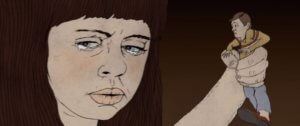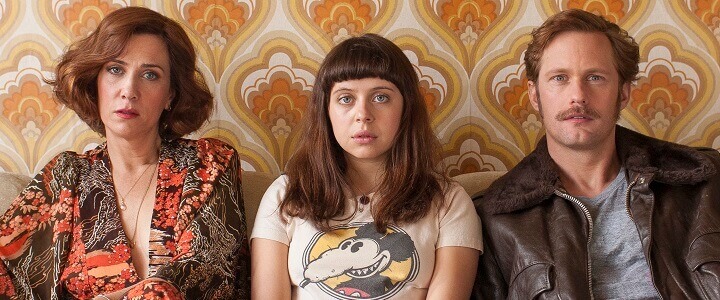Review: The Diary of a Teenage Girl (2015) ★★★★
Whenever a film addresses sex in a way that is neither prudish nor sensationalized, it should be lauded as something of a victory. This is a rather sad state of affairs, that what should be a pervasive sentiment is still shunned as fringe or taboo. It is pathetic that we, as a society, still recoil when confronted with unconventional sex, or any form of sexuality that is deemed improper for public consumption; and yet, that is precisely where we are, and where we will probably remain for the foreseeable future. Nonetheless, there are still those few films that attempt to shake us from the bonds of our priggishness, and launch us into the 21st century (or where the 21st century should be). Marielle Heller’s The Diary of a Teenage Girl is, by and large, such a film.
Based on the graphic novel of the same name by Phoebe Gloeckner, the film follows Minnie (Bel Powley), a 15-year-old girl discovering the complexities of her own sexuality in the midst of the sexual and cultural revolution taking place in 1970’s San Francisco. Minnie sets her sights on her mother’s boyfriend, Monroe (Alexander Skarsgard), who, while initially reticent, gives in to her advances. The two continue their extended tryst in secret, with varying degrees of devotion to one another.
Much of what sets The Diary of a Teenage Girl apart from other films in the coming-of-age genre is its relatively apathetic tone toward underage sex and adolescent female promiscuity. For the vast majority of the film, Minnie’s decisions to take part in increasingly risky sexual behavior are merely treated as part of the act of growing up. It is not really promoting this kind of behavior, and, until the final sequences, is not condemning it either. This kind of ambiguity is refreshing, but somewhat disappointingly, the film devolves into familiar territory, even going so far as to blame Monroe for any and all wrongdoing. While one is inclined to argue that a 30-something man should know better than to have sex with an underage girl, and should practice maturity and self-control, it is difficult to assign all the blame on his character (as the film ultimately does), having watched as two people with sexual urges for one another engage in consensual sex, primarily driven by Minnie’s advances.

This is a rather unpopular view, backed up by laws and general social guidelines regarding sex, but there is no denying the reality of burgeoning sexuality. We have all been teenagers at one time. We have all experienced sexual urges before society deemed us old enough to act on those urges. This glimpse into the inner desires of a teenager and an older man might even be considered dangerous by those with more traditional sensibilities.
It seems the filmmakers were sensitive to this fact, which is probably why Monroe is treated harshly in the final minutes. Whether or not you agree with the apparent turn against his character, it does seem to negate much of the nonjudgemental tone of the first half of the film, and the sexual liberation of the times. And to be fair, there is no denying that Monroe is kind of a creep, who uses an immature girl’s repressed sexuality and confusion to his own ends; but in the end, the film treats Minnie as the undisputed moral superior, looking down on Monroe’s perversion and callous disregard for both Minnie and her mother, Charlotte (Kristen Wiig), which comes across as a grossly naive conclusion to come to, based on the preceding events in the film. The ending arguably negates the undertones of liberation in an attempt to absolve the protagonist of all responsibility regarding her sexual experimentation with a much older man.
Disappointing tonal shifts aside, The Diary of a Teenage Girl captures the atmosphere of liberation in 1970’s San Francisco. Minnie, as an aspiring cartoonist, draws images of herself and the people around her, which frequently come to life in exceptionally well-crafted animated sequences. The style of the cartoons is reminiscent of Fritz the Cat (1972), among other cartoons and comics of the era. These surreal sequences transport the viewer to an earlier time, when expanding one’s mind, through sex or drugs or even art, was of the utmost importance.

While the tone is generally comedic, it never ventures into the ridiculous. Minnie’s struggle to come to terms with her ravenous sexuality is treated with the utmost deference, and much of what is humorous in the film simply arises from the daily blunders of teenage life, from disappointing friends to the embarrassment of living with a free-spirited parent. While the story leans more on the dramatic aspects of Minnie’s life, the mental gymnastics and emotional extremes that teenagers are so known for are as funny as they are sincere for Minnie.
Ultimately, this is a fantastic film, oozing with nostalgia for the 1970’s. Although generally indifferent in its view of the sexual revolution and its real-life, day-to-day consequences, the film undoes much of the moral ambiguity that make it so emblematic of the era in which it is set. Despite this shortcoming, The Diary of a Teenage Girl is a truly remarkable and altogether unique coming-of-age story.
Rating: ★★★★ out of 5
If you’d like to watch The Diary of a Teenage Girl , it is currently available to rent or purchase via Amazon here.

